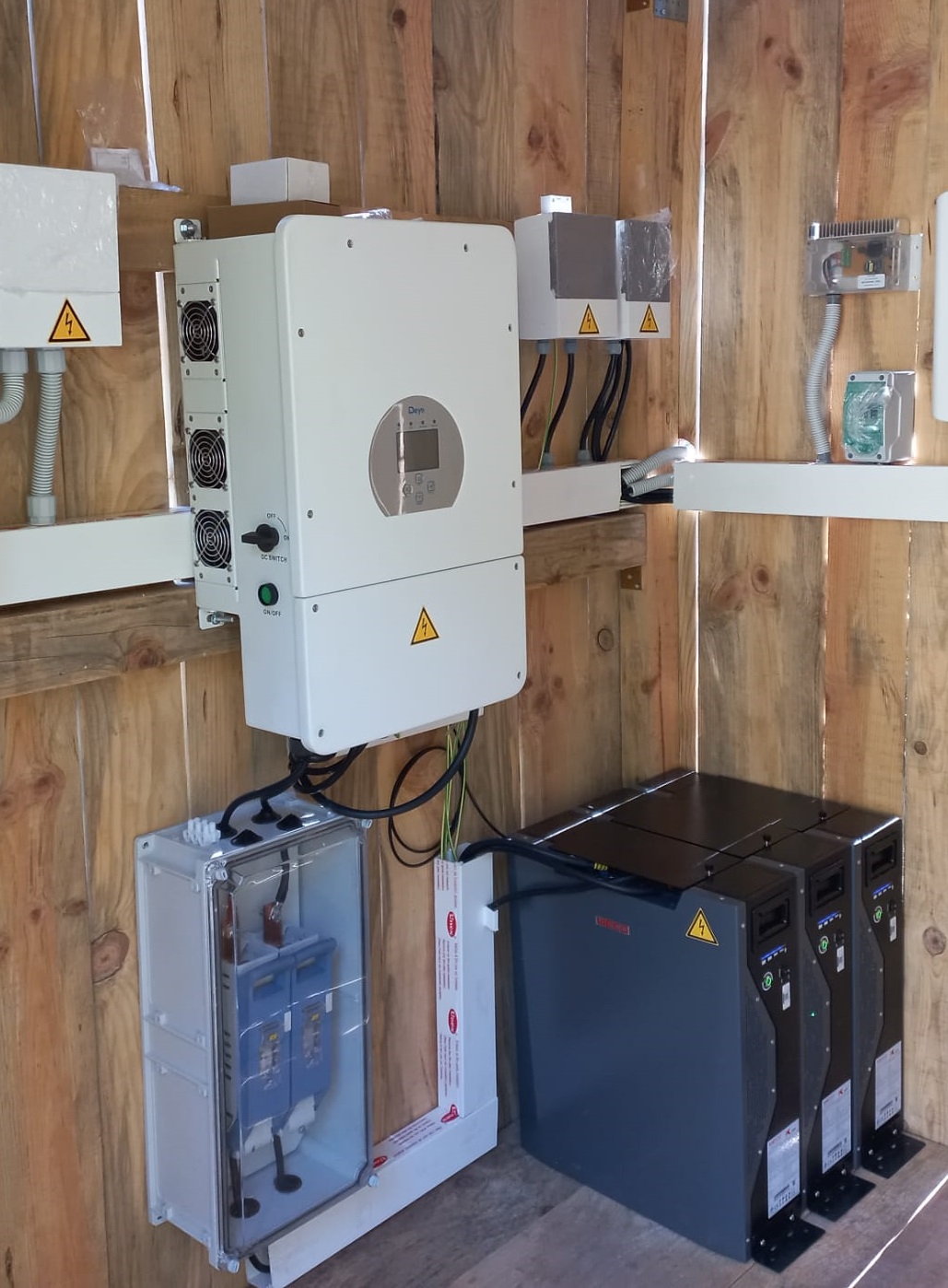Battery bank
MODULAR ENERGY STORAGE: RESIDENTIAL AND SMALL COMMERCIAL BATTERY FROM 5.3 TO 79.5Kw
ELECTRICAL SELF-CONSUMPTION WITH BATTERY
Self-consumption with batteries is an interesting alternative, especially for solar energy but also if you are connected to the grid and without photovoltaics.
It presents the opportunity to generate electricity at the right time and use it when needed. Therefore, it allows you double autonomy: you can produce and consume on your own.
In fact, as the current electricity market is regulated, batteries can provide stability to the daytime tariff price. This can be very useful in the residential sector with photovoltaic installations and which send the surplus to the grid. It can also be very interesting in small and medium-sized companies that have tariff contracts (P1-P6).
In the residential sector, if a battery bank is available, a hybrid grid inverter can be used to program battery charging during ‘off-peak’ hours of low tariff prices and to reschedule discharge during peak hours, where the purchase cost is very high. Naturally, if there is a photovoltaic installation, it is possible to avoid sending the surplus produced and allocate it to battery charging. This is feasible with hybrid inverters capable of managing the battery, the photovoltaic input, the public grid and consumption.
In small industries with a fixed contract for time slots (P1-P6), the battery can be a key element in order to maintain the purchase price of peak rates (P1-P3), at a much lower price. In fact, if during the low price or valley rate hours (P5-P6) they are used to charge the battery (with a hybrid inverter) and the battery power is consumed during the peak rate hours (P1-P-3), the savings in electricity costs can be very important.
The savings will come from the energy not consumed from the grid (especially if there is photovoltaic), from having a cost without peak increases (or in any case with much smoother peaks), and with amortization of the fixed battery cost.
Uninterruptible power supply (UPS) with WeCo 5K3 XP from 5.3 kW to 768 kW.
The UPS is a fundamental component for communications infrastructures, as it guarantees the constant availability of electricity, thus avoiding data loss in the event of a power failure. It is also essential to ensure the proper functioning and extend the useful life of the devices connected to it, as it protects them from surges and voltage drops.
The WeCo 5K3 XP 48V lithium battery has a dual BMS for use in high and low voltage. It has more than 7,800 100% discharge cycles. The new model has WiFi and Bluetooth with a monitoring application included as standard. It allows expansion with up to 15 batteries in series parallel and thanks to the HUB we can expand up to 105 batteries to make 556 kWh useful in 48 volts and up to 768 kWh in high voltage.
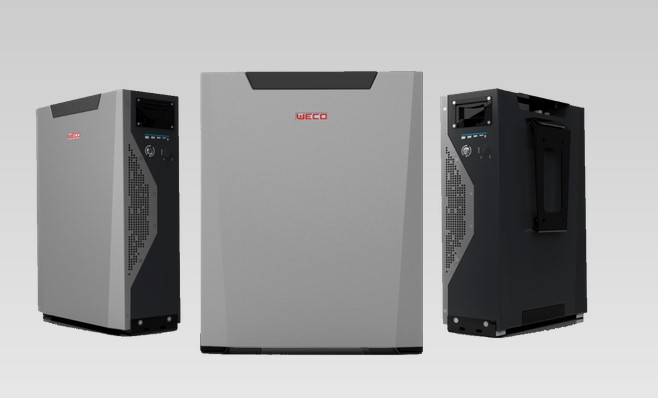
The High Voltage series is a high voltage lithium-ion battery system. It provides reliable backup power for supermarkets, banks, schools, farms and small factories to smooth the load curve and achieve maximum load transfer. It can also improve the stability of renewable systems and promote the application of renewable energy.
EMMAGATZEMATGE MODULAR D’ENERGIA: PRODUCTE RESIDENCIAL I PETIT COMERÇ DE 5,3 A 79,5Kw
The modular energy storage system is designed with a high degree of integration, exceptional reliability and long service life. With a wide range of operating temperatures, this system offers extraordinary flexibility and scalability. Each battery module has a capacity of 5.37 kWh. The complete system supports 15 battery modules in series, so its total energy capacity can reach an impressive 79.5 kWh, perfect for any RESIDENTIAL or large-scale INDUSTRIAL AND COMMERCIAL installation up to 768 kW.
WeCo 5K3 XP is the new model from WeCo. It has improvements over the previous model 5K3 HV/LV, such as the introduction of integrated WiFi and Bluetooth as standard. With the new WeCo 5K3 XP we can achieve up to 15 parallels without additional accessories. The WeCo 5K3 XP includes a new generation BMS with dynamic equalizer. WeCo 5K3 XP It is the only lithium battery model on the market patented to operate in high and low voltage thanks to a double BMS.
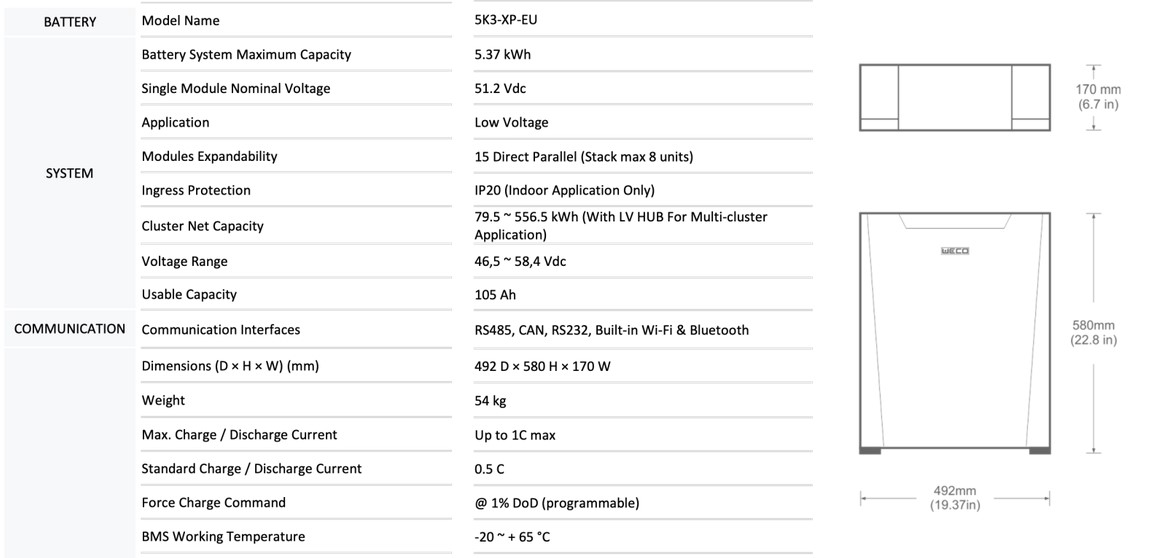
EXAMPLES OF GROUPS: PRODUCTS FOR INDUSTRIES, MEDIUM-SIZED COMPANIES AND FARMS
10.6 A 768 KW The WeCo 5K3 XP lithium battery has a 10-year warranty. The main advantages:
- Universal compatibility: Weco lithium battery has the highest compatibility on the market and can work with communication with the main brands on the market such as Deye, Studer, Schneider, Solax, Victron, Sofar Solar, Voltronic, SMA, Growatt, Goodwee, Imeon.
- Dual BMS for low and high voltage: the 5K3 XP battery has a dual BMS and a dual connection port. If we want to use it in low voltage at 48V we will use the CAN A output and the low voltage connection port. If, on the other hand, we want to use it in High Voltage, we will use the CAN B output and the High Voltage quick connector port. For high voltage it is necessary to purchase the WeCo HV Box accessory.
- Allows 100% discharge: The WeCo lithium battery has 7,800 cycles at 100% discharge. We can completely discharge the battery and use its full capacity. In addition, if we make shallower discharges, such as 80%, we will increase the number of cycles to more than 10,000.
- 1C charging and discharging current: WeCo lithium battery allows charging and discharging at 1C, so with a single WeCo 5K3 lithium battery we can charge and discharge at more than 5,500 Wh (110 Ah) nominal. In just 1 hour we can charge 90% and use 5kW inverters with a single battery without having warranty problems. We can also discharge a peak of 2C (10,000 W) for 30 seconds to initiate high power consumption.
- Operation in extreme temperatures: The WeCo 5K3 lithium battery can be discharged in an extreme temperature range between −20 ºC and +65 ºC and charged between −7 ºC and 55 ºC. No other lithium battery on the market has this temperature range. These are the only lithium batteries certified by telecommunications operators for desert environments. A mountain shelter is also no problem with weco batteries, because their autonomy is even higher than that of lead batteries.

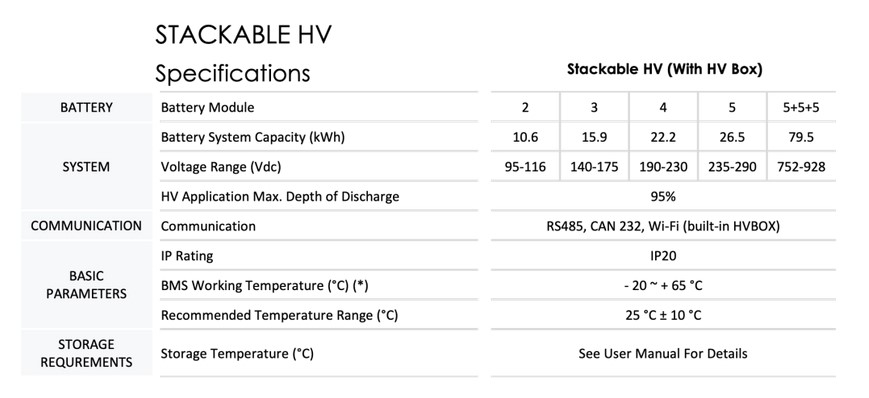
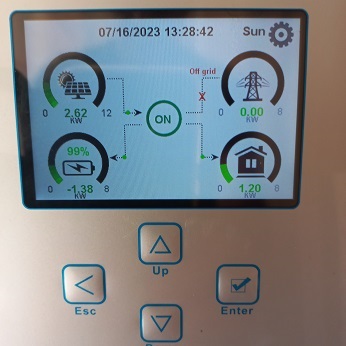
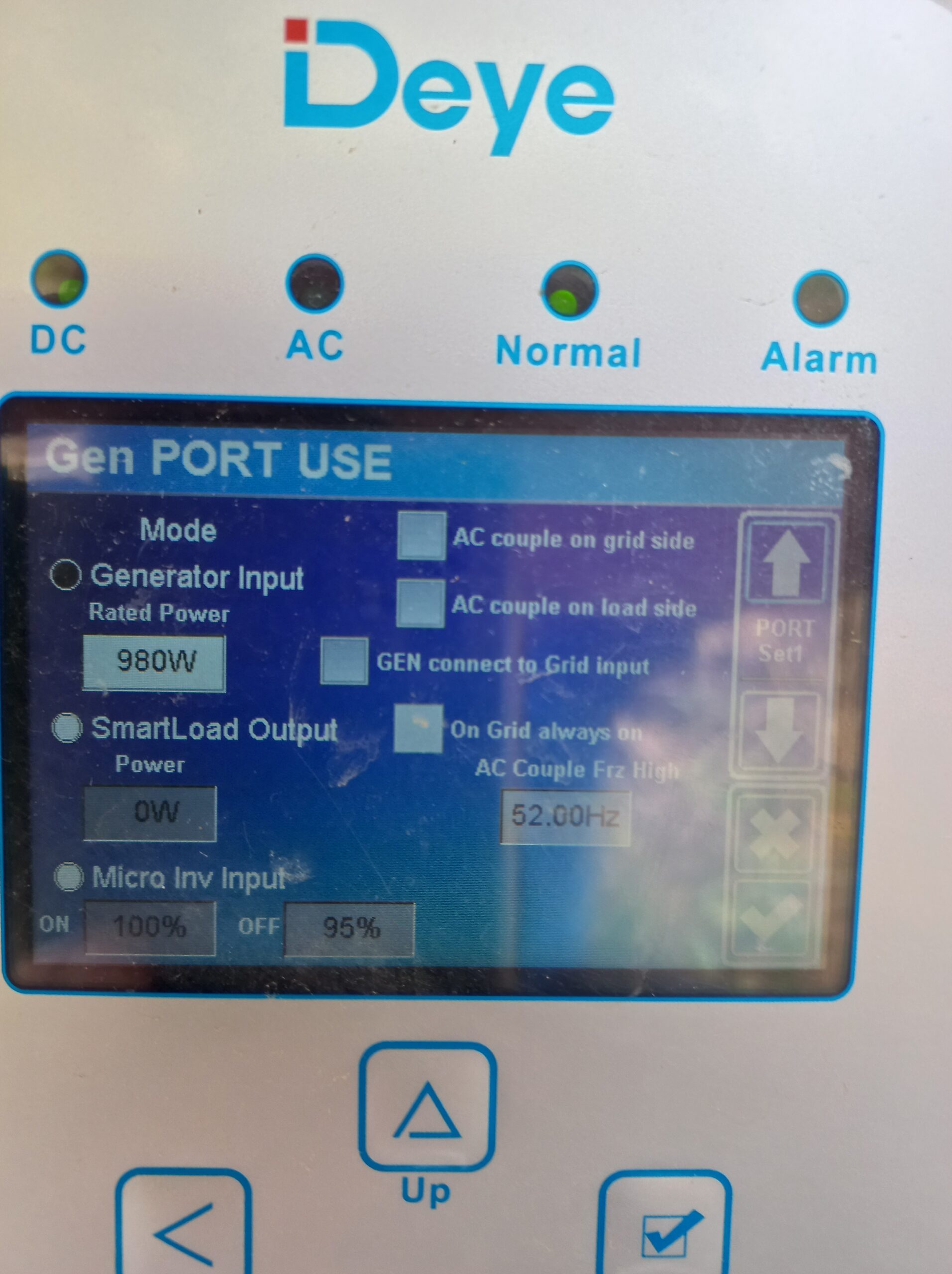
OUR UPS SELF-CONSUMPTION SYSTEM WORKS ON DEYE INVERTERS
Large LCD touch screen for monitoring and configuration. The Deye hybrid inverter has a large touch screen where you can configure all the operating possibilities of the inverter as well as control in the greatest detail the daily production, the battery status, the energy flows and even access the BMS of the lithium batteries to see the cell, temperatures and voltages.
No computers are needed like in other systems, simply from its screen and touch screen we can use and control all the functions of this inverter.
Deye is the most complete hybrid inverter on the market, capable of operating in isolated installations without a grid, with the possibility of being paralleled in single-phase or three-phase in up to 16 devices. Below we will detail its main characteristics:
- 10-year warranty on your Deye hybrid inverters.
- WiFi monitoring included in the Deye hybrid inverter.
- Time programming and deduction of surpluses.
- Compatible with lead, gel and lithium batteries: This equipment allows the use of any type of battery on the market: lead, gel, AGM and is compatible with most lithium batteries.
- Equalization charging available up to 30 W and BMS port for connection to 24 V WeCo or Pylontech batteries.
- Parallelizable up to 16 units.
- Self-consumption operation. Management of surpluses thanks to the Smart Load function and AC coupling of a grid inverter. “Peak Shaving” function to supplement grid power. Deye Hybrid inverters have a function in which they can supplement grid power or a generator with batteries in the case of low-power grids or contracts. If we have 2 kW of subscribed power, for example, we can select the value 2000 W in Peak Shaving and when the demand exceeds 2000 W, the inverter will take the remaining batteries or solar panels to supplement so that the grid does not exceed its subscribed power. This feature is very useful in end-of-line or old transformers where the company cannot supply more energy to the house.
SINGLE-PHASE MODELS 230Vac -50Hz:
-
Deye Sun Hybrid 3 kW 1MPPT
-
Deye Sun Hybrid 5 kW 2 MPPT
-
Deye Sun Hybrid 6 kW 2 MPPT
-
Deye Sun Hybrid 8 kW 2 MPPT
-
Deye Sun Hybrid 10 kW 3 MPPT
-
Deye Sun Hybrid 12 kW 3 MPPT
-
Deye Sun Hybrid 16 kW 3 MPPT
THREE-PHASE MODELS 400Vac -50Hz:
-
Deye Sun Hybrid T 6kW 2MPPT
-
Deye Sun Hybrid T 10 kW 2 MPPT
-
Deye Sun Hybrid T 12 kW 2 MPPT
-
Deye Sun Hybrid T 20 kW 2 MPPT
-
Deye Sun Hybrid T 20 kW 3 MPPT
-
Deye Sun Hybrid T 30 kW 4 MPPT/ ALTA TENSIÓ DE BATERIA
-
Deye Sun Hybrid T 50 kW 4 MPPT /ALTA TENSIÓ DE BATERIA
LITHIUM BATTERIES IN COLD WEATHER: EVERYTHING YOU NEED TO KNOW!
LITHIUM BATTERIES IN COLD WEATHER
- Lithium batteries do much better in winter conditions than other types of batteries, but you still need to take care of them. With the right preventive measures, batteries can hold up perfectly in winter conditions. Also, you first need to see why they need to be protected from cold environments.
- A battery’s job is to store and release energy. Cold weather can get in the way of these important functions. Just as it takes your body several minutes to warm up after being outside, so does a battery. Cold temperatures increase a battery’s internal resistance. This can reduce its ability to charge and discharge. The battery can’t release as much energy or hold it in cold temperatures.
- First of all, you need to choose battery models that can initially offer better conditions in the cold. In the photo you can see the plate of the Weco 5.3 models. In the temperature range it indicates that they can work between -20 to +50ºC. Likewise, the behavior in the cold will not be the same. In fact, below the values of -5ºC, the battery loses efficiency. This means that you will have to charge these batteries more frequently during winter weather. That is, in cold climates the ideal is not to force the SOC values to their maximum. This may also be good for the useful life and charging cycles.
- Therefore, in cold climates we recommend programming the charge/discharge to SOC values well above normal values. For example, the Weco 5.3 model allows a discharge of up to 100% of the SOC. For safety reasons, they can raise it to 90%. Well, in cold climates we recommend SOC discharges to 15 or 20%. Very tight values, but which will allow the battery to be charged/discharged slowly. And in some way be active, which will also produce internal heat.
ARE LITHIUM BATTERIES SAFE?
There are three main types of lithium batteries. Each model has different properties and has different functions.
It consists of lithium ion (Li-ion), nickel-manganese-cobalt (NMC) and lithium-ferro-phosphate (LiFePO4 or more commonly related to LFP) batteries. Li-ion and LiFePO4 may be related, but they are not the same.
- Lithium ion polymer batteries: These batteries use lithium polymers with an electrochemical material and have a high energy capacity compared to other conventional batteries. They are ideal for use on mobile devices and other applications that require high security. It contains batteries for mobile phones or small electrical devices. The typical voltage is 3 V. Improper handling of LiPo batteries can cause fires, explosions and inhalation of toxic fumes. The problems mainly occur due to excessive load (high mass load volts/amps or excessive load speed). If charging is too fast (chargers defective or in poor condition), the internal temperature of the battery increases. In extreme situations, one of the cells or joints breaks down and causes a leak.
- NMC batteries are batteries used in electric vehicles, electric bicycles and other electric propulsion systems. The combination of the sun cathode being one third of nickel, one third of manganese and one third of cobalt, is also connected as 1-1-1. Cobalt is expensive and its availability is limited. The NMCs transport oxygen to the molecule that carries the energy charged to the battery cells. This release occurs when an NMC cell experiences what is known as a thermal release. It is a cream that releases oxygen during the process with a little gas. It is not known when the leak is repaired… or when the gas runs out. This phenomenon can happen when the battery becomes overheated and can potentially catch fire or explode. This risk increases when the battery is overcharged, punctured, or exposed to high temperatures. A simple solution is to not let the battery discharge and charge it slowly.
- LFP (LiFePO4) batteries are used for large loads. LFP has a slightly lower energy density, meaning LFP cells are slightly larger and heavier and contain the same amount of oxygen as NMC cells. LFP cells don’t require much oxygen. Assuming LFP cells are defective, broken, crushed, or punctured, the thermal reaction is seven times less severe than that of an NMC product. Therefore, LFP is considered safe and ideal for residential environments, whether for stationary appliances, solar storage, or electric buses for public transport.
- HOW TO KEEP LFP BATTERIES SAFE
- Each manufacturer provides its own technical specifications, and you should follow the instructions in each instruction manual. Also, at a general level: Battery lifespan is determined by life cycles. A life cycle occurs when the battery reaches its maximum discharge point. So, if an LFP battery has 7,000 life cycles and a 95% discharge limit, each time the battery discharges below 95%, one cycle is subtracted (whether in a day or 25 times a day). As a safety measure, I recommend always working 10 points above the maximum discharge value.
- Battery charging and discharging should be done at the appropriate rate. Don’t let the battery discharge too quickly. If the manufacturer indicates maximum discharges (for example, 80A, approximately 17kW in single-phase voltage), don’t exceed them.
- If you are in an isolated area (without an electrical grid), the battery is the essential heart of the entire system. I recommend not skimping on storage units. If your home has a daily consumption of 7.5kWh/d (for example), the battery storage should be at this value or higher. A lower value will result in a constantly high battery charge/discharge. Two batteries in parallel compensate for discharge/charge better than a single model.

